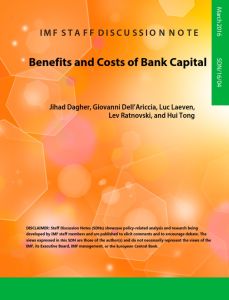
Jihad Dagher, Giovanni Dell’Ariccia, Luc Laeven, Lev Ratnovski and Hui Tong
Benefits and Costs of Bank Capital
IMF, 2016
What's inside?
The appropriate level of bank capital to absorb losses is a subject of unending debate.
Recommendation
Banks need capital to help them withstand losses. Yet what constitutes an adequate level of reserves is a topic of heated discussion among bankers, regulators and policy makers. Lower buffers could leave systemically important banks at risk, while stringent requirements might unduly constrain credit availability and raise financing costs for businesses. This scholarly study from the International Monetary Fund examines a dynamic, complex question that cuts across regulatory remits and economic systems. getAbstract recommends it to bank executives and policy makers.
Take-Aways
- Banks and regulators continue to debate the proper level of bank reserves that protects institutions and the financial system but that still affords businesses access to capital.
- Research shows that, in advanced economies, capital in the range of 15%–23% of risk-weighted assets would have been enough to buffer losses in most past banking crises.
- Capital increases need to happen gradually and allow for heterogeneity across banks.
- Overly stringent rules could spur banks to engage in regulatory arbitrage by moving their lending businesses into less-regulated financial intermediaries, or shadow banks.
- Crisis avoidance and mitigation may succeed through better capital provisioning, but other regulatory efforts can improve banks’ financial stability and, by extension, social welfare in general.
Summary
Regulatory debate centers on whether banking reforms such as Basel III can adequately forestall future banking collapses or whether increased controls are punishing economic growth. Banks and their regulators continue to argue the appropriate level of capital reserves that protects institutions and the financial system but that still affords businesses access to capital. Capital that is sufficient to absorb bank losses should not be an absolute amount but rather a range that, ideally, lets systemically important banks avoid having to resort to taxpayer funding in times of crisis. Research shows that, in advanced economies, capital in the range of 15%–23% of risk-weighted assets would have been enough to buffer losses in most past banking crises. Mandated capital exceeding this threshold would have offered diminishing marginal benefits. As a practical matter, banks typically hold excess reserves and may use other “bail-in-able” mechanisms to absorb losses, so statutory limits might impose a somewhat lower capital requirement than the 15%–23% range indicates.
“Few issues in the postcrisis policy debate have been more contentious and elicited a wider range of firmly held views than the appropriate level of bank capital.”
Institutional, regional and structural factors also affect suitable capital levels. Bank losses relative to assets during crises have been greater in emerging markets, where regulators demand higher reserve requirements than in the OECD. Yet developing economies’ banking systems tend to be smaller, and their losses have narrower macroeconomic impacts. Capital increases must occur gradually and allow for heterogeneity across banks, as the short-run costs of incorporating more capital could be much greater than the long-term costs. Banks could pull back on creating loan assets to achieve stepped-up capitalization. Regulators also could urge banks to bolster capital via new equity issuances or from retained earnings.
“There is more to crisis prevention than improved capital buffers.”
Overly stringent rules could spur banks to engage in regulatory arbitrage by moving their lending businesses into less-regulated financial intermediaries, or shadow banks. Broadening the reach of macroprudential monitoring into the shadow banking ecosystem could address this risk. Crisis avoidance and mitigation may succeed through better capital provisioning, but other regulatory efforts can improve banks’ financial stability and, by extension, social welfare in general: Regulators can impose higher standards for the quality of bank capital and for supervision. Better macroprudential rules would make regulatory arbitrage less attractive and discourage banks’ assumption of excessive risk.
About the Authors
Jihad Dagher, Giovanni Dell’Ariccia, Lev Ratnovski and Hui Tong are economists at the International Monetary Fund. Luc Laeven is director-general of research at the European Central Bank.
This document is restricted to personal use only.
My Highlights
Did you like this summary?
Get the ReportThis summary has been shared with you by getAbstract.
We find, rate and summarize relevant knowledge to help people make better decisions in business and in their private lives.
Already a customer? Log in here.


















Comment on this summary